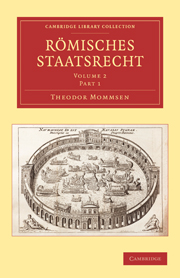Book contents
- Frontmatter
- Contents
- Das Königthum S. 3—15
- Die magistratische Befugniss des Oberpontifex S. 16—69
- Das Consulat S. 70—124
- Die Dictatur S. 125—153
- Das Reiterführeramt S. 156—164
- Der Consulartribunat S. 165—175
- Die Prätur S. 176—216
- Die Provinzialstatthalterschaft S. 217—246
- Der Volkstribunat S. 247—303
- Die Censur S. 304—442
- Die Aedilität S. 443—491
- Die Quästur S. 492—538
- Magistratische Offiziere S. 539—545
- Die magistratische Geschwornenleitung S. 546—555
- Der Vigintisex-, später Vigintivirat S. 556—571
- Ausserordentliche Beamte für die Reservatrechte der Gemeinde S. 572—600
- Ausserordentliche Aushülfsbeamte S. 601—637
- Die Senatsboten (legati) S. 638—661
- Die ausserordentlichen constituirenden Gewalten S. 662—697
Die Provinzialstatthalterschaft S. 217—246
Published online by Cambridge University Press: 29 August 2010
- Frontmatter
- Contents
- Das Königthum S. 3—15
- Die magistratische Befugniss des Oberpontifex S. 16—69
- Das Consulat S. 70—124
- Die Dictatur S. 125—153
- Das Reiterführeramt S. 156—164
- Der Consulartribunat S. 165—175
- Die Prätur S. 176—216
- Die Provinzialstatthalterschaft S. 217—246
- Der Volkstribunat S. 247—303
- Die Censur S. 304—442
- Die Aedilität S. 443—491
- Die Quästur S. 492—538
- Magistratische Offiziere S. 539—545
- Die magistratische Geschwornenleitung S. 546—555
- Der Vigintisex-, später Vigintivirat S. 556—571
- Ausserordentliche Beamte für die Reservatrechte der Gemeinde S. 572—600
- Ausserordentliche Aushülfsbeamte S. 601—637
- Die Senatsboten (legati) S. 638—661
- Die ausserordentlichen constituirenden Gewalten S. 662—697
Summary
Die römische Republik hat bis über den ersten punischen Krieg hinaus keine Provinzen gekannt. Die Aufstellung des Gegensatzes zwischen Italien und den uberseeischen Besitzungen so wie die Institution des Provinzialstatthalters, an dem das freie Gemeinwesen sein Ende und seinen Herrn zu finden be stimmt war, ist das Ergebniss des ersten Krieges, der die Nation tiber ihre naturlichen Grenzen hinaus gefuhrt hat. Der Eroberung Siciliens (J. 513 d. St.) folgte die Einsetzung der sicilischen Prätur (S. 180) auf dem Fusse (J. 527 d. St.); und in un-übersehbar langer Reihe schlossen daran weitere Eroberungen unabhängiger und Einziehungen botmassiger ausländischer Ge-biete sich an, die das romische Staatsrecht als Umwandelung in die Form der Provinz bezeichnet, während die umgekehrte Verwandlung provinzialen Gebiets in italisches nur ein einziges Mai vorgekommen ist, als im Anschluss an die Einrichtungen Caesars im J. 712 das cisalpinische Gallien definitiv mit Italien vereinigt ward). Die Aufgabe des von den Magistraten handeln-den Abschnitts des römischen Staatsrechts ist es weder den Begriff der provincia speciell zu erlautern noch die einzelnen Provinzen aufzuzählen und die mannichfaltigen Besonderheiten ihrer Verwaltung darzulegen); indess auch in ihm verlangt eine Stelle die allgemeine Erorterung der Magistratur oder vielmehr der verschiedenen Magistraturen und Quasimagistraturen, die die spatere) Terminologie unter dem Namen des praeses provinciae), des in dem Regierungsbezirk höchsten und darum den Vorsitz füh-renden Beamten), des Provinzialstatthalters zusammenfasst.
- Type
- Chapter
- Information
- Römisches Staatsrecht , pp. 217 - 246Publisher: Cambridge University PressPrint publication year: 2010



